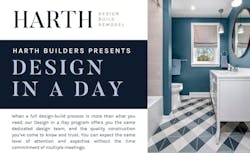Building A Small Projects Division from the Ground Up
I’ve been president of Harth Builders for more than two decades. We have 80 employees and our 2023 revenue was $25 million. We’re forecasting $28 million in 2024.
Three years ago, we started a small projects division called Harth Home Services. The initiative was in response to past clients, who already had a great relationship with our team, and were now seeking a smaller project.
Our budget for 2024 is $3 million—almost double the number from 2023. This concierge-type service is an important part of our overall growth, and we now have two salespeople dedicated to the division full time.
Initially, many of the jobs came while we visited a project to take care of warranty items, and the client would then request additional work.
Over time, we became more intentional about the sales and service cycle, closely intertwining our Client Services Department with Harth Home Services.
Now, instead of clients calling us with warranty work, we reach out to them every six months during their two-year warranty period. This strengthens our existing relationship, and creates an introduction to the home services division.
A Learning Process
Since starting Harth Home Services, we’ve had to rethink our processes several times. It’s very similar to building a new company, and we experienced the same growing pains as back in the beginning with Harth Builders.
The business reached a no man’s land where we needed more people to keep up with demand, but also needed to sell more to support those new team members.
One area where we made a big change was staffing. Initially, our team members were either on Harth Home Services or worked elsewhere in the company. Over time, we realized that it’s best not to have a barrier between the two. The idea is that everyone should be able to work on small jobs or a larger design-build project.
We also changed the way we estimate. When the division first launched, we used a cost-plus model, but that led to problems. We now operate with a fixed-price system.
A Different Approach
As mentioned, we faced the same challenge as many new remodeling business owners: In the beginning there’s one person selling projects and managing production, but as the company grows, it’s necessary to separate the sales function from the field. That adds complexity, and you need a hand-off process, and project meetings.
Yet we didn’t want this division to look like design build with weekly meetings and as many as five people at any given time to help move things forward. The idea with smaller jobs is to run fast and lean. As a result, we came up with a hybrid approach.
A New Model
The system we developed combines some of our design-build steps with a leaner approach.
For example, we still need to meet on the smaller projects, we need a hand-off, and we need to set expectations. But we found that a preconstruction meeting and weekly updates are unnecessary in most cases.
To help with the systems and processes, we moved one of our assistant project managers over to Harth Home Services to act as a project supervisor.
We also now charge $150 to come out for an initial consultation and proposal because otherwise we would have too much work. That fee covers 90 minutes of an individual’s time to review the job in person.
Designing Smaller Jobs
Some of the Harth Home Services projects need design work and so we created a billable model that ties in the design team.
Design in a Day works on an hourly basis. It’s perfect for projects such as a powder room where elevations and drawings are unnecessary, but we do need some design work to place and fit the elements together. A lot of product selections go into a powder room, but it’s not complex from a construction standpoint.
The streamlined design model is $950, which gives the client time with a designer and salesperson.
In order to ensure it’s the right fit, the project needs to meet some parameters. For example, we can’t accommodate structural changes or an unusual geometric shape.
Defining Scope
There are no hard and fast rules regarding whether a project is part of Harth Home Services or our design-build division. Yet there are some guidelines that we’ve found to be effective.
Interestingly, cost is not necessarily one of them. We need some larger projects in this division in addition to the smaller, fast and furious jobs. The guidelines are more around complexity.
One criteria we look at is the number of trades involved with the project.
Ideally, a home services job should have no more than a single trade partner, but there are exceptions, for instance, outdoor elements might need two or three trades, but still falls into that division.
Future Plans
We track the whole Harth Home Services division as a separate classification, including revenue and cost of goods. We don’t allocate overhead into it.
At this point, the division accounts for about 10% of the company’s total revenue.
Our goal is to grow revenue to $5 million in three years, which would make it almost 15% of the company.
We’ve found this to be a great solution for clients with smaller projects who don’t need full design build.
About the Author

Greg Harth
Greg Harth is a former engineer and president of Harth Builders.


